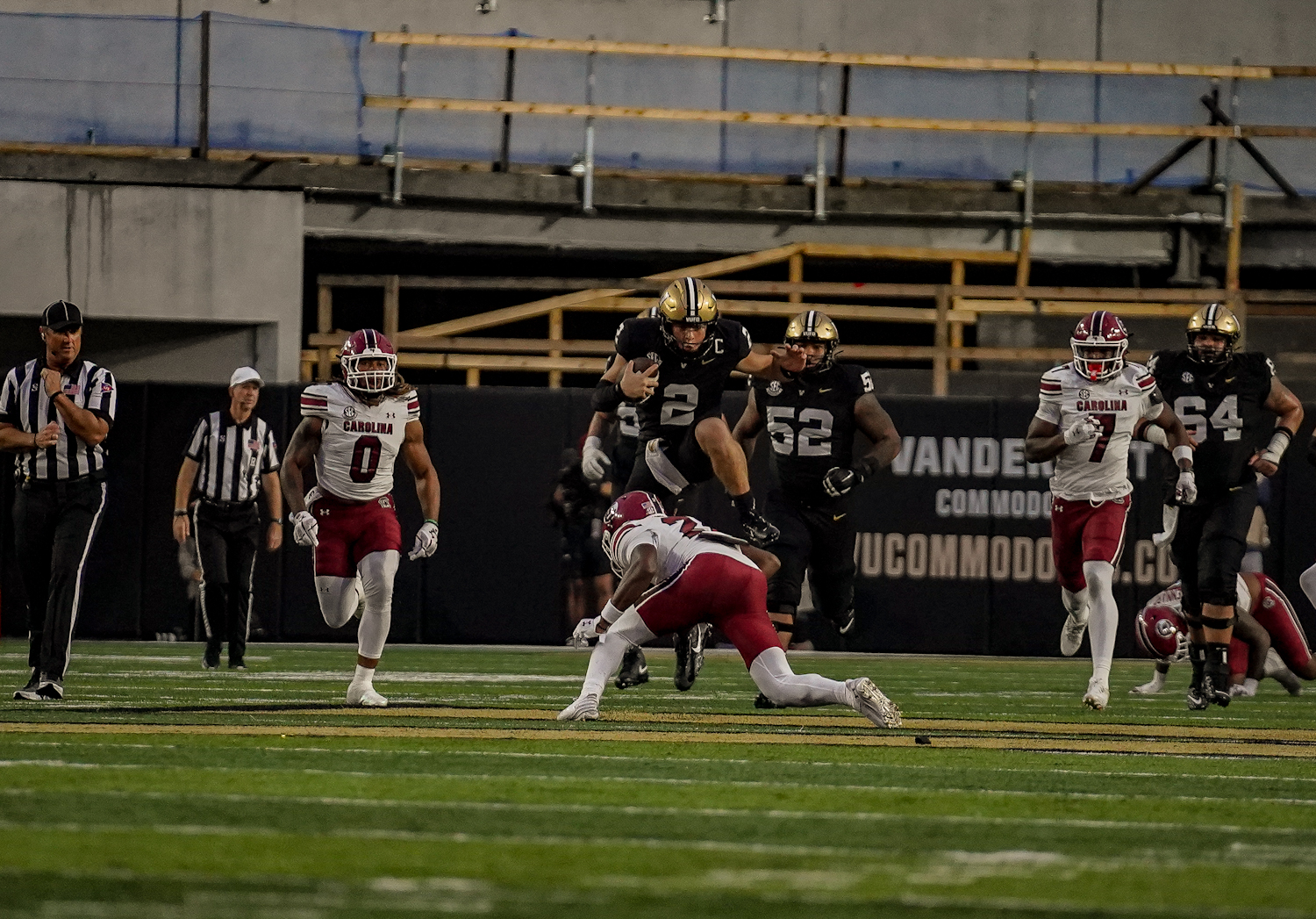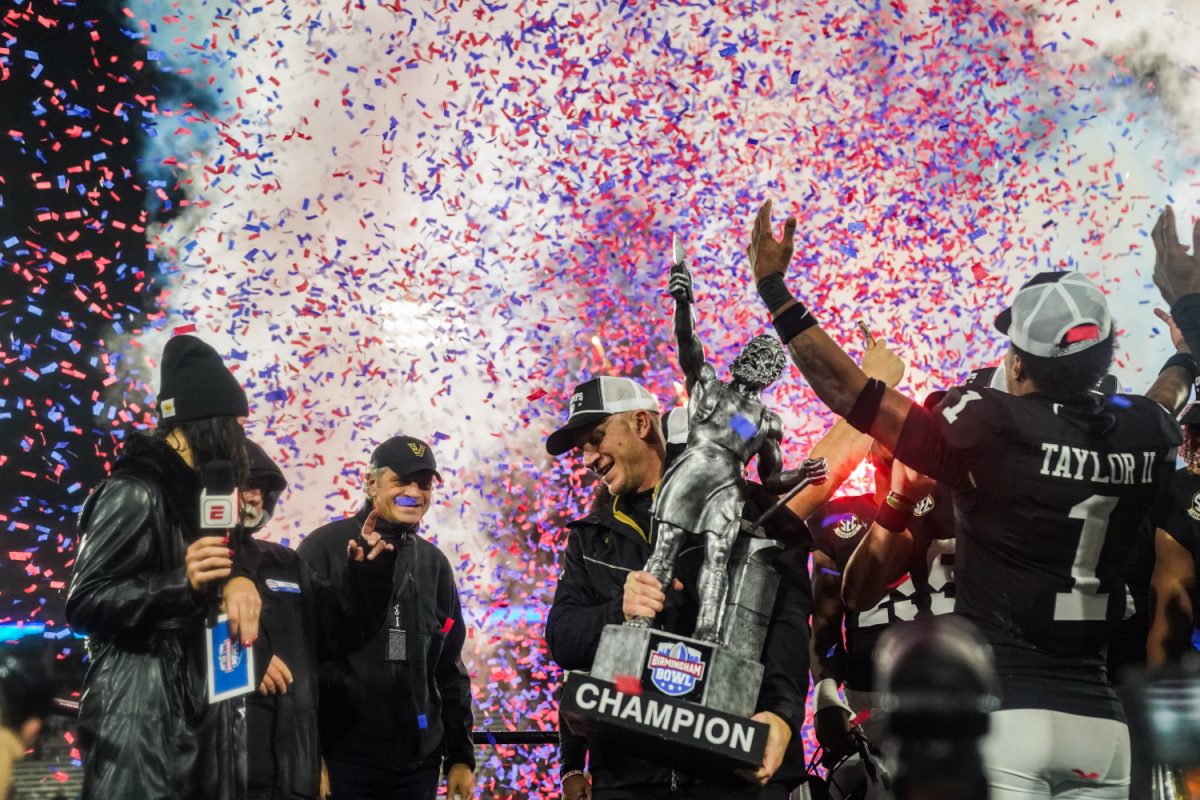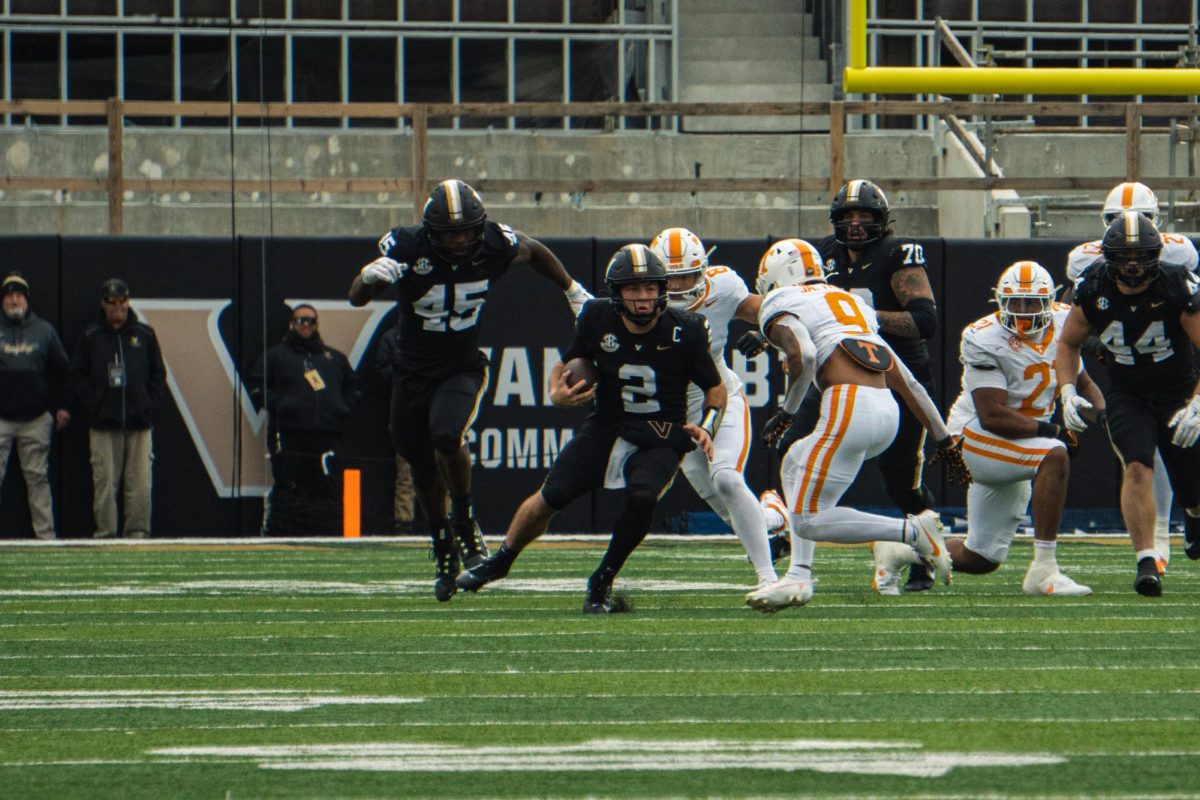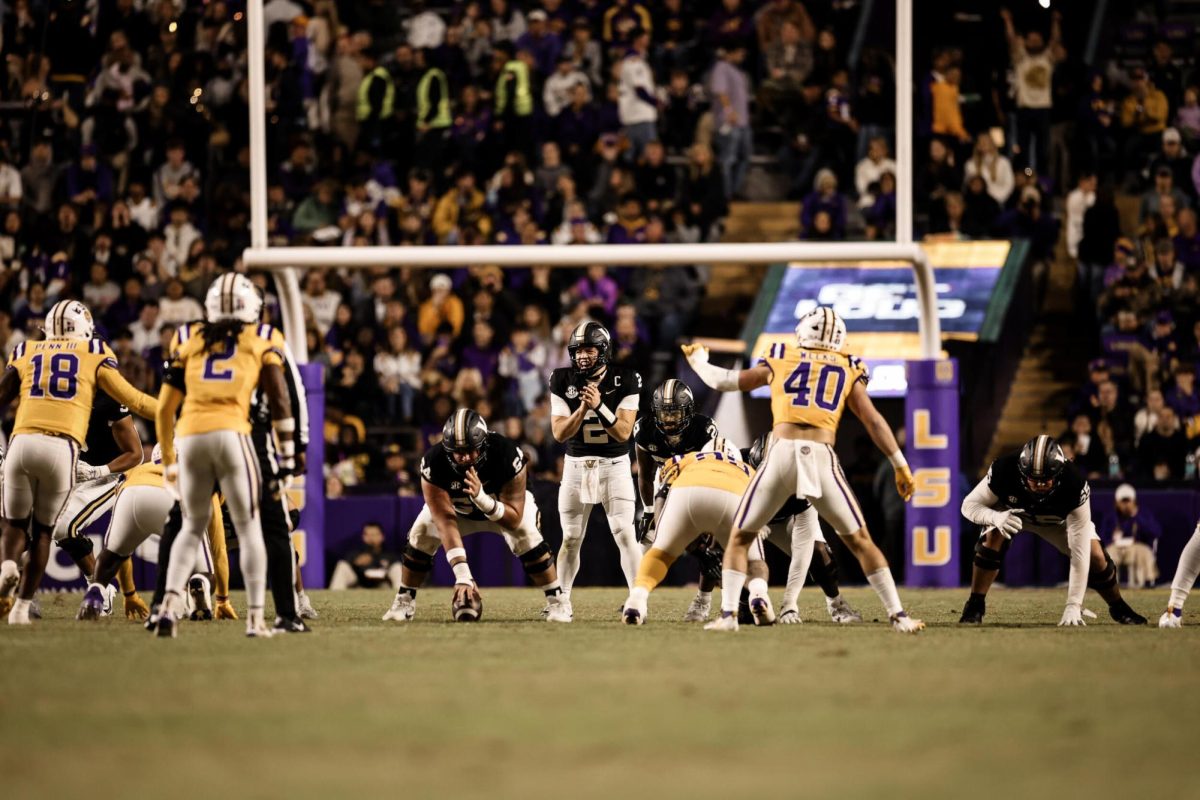“That was a three-phase ass-kicking,” head coach Clark Lea said postgame following Vanderbilt’s 28-7 loss to South Carolina on Nov. 9.
He’s not wrong.
The Commodores were outmatched all afternoon by a physically dominant group of Gamecocks that entered the game riding the high of a 44-20 win over Texas A&M in Week 10. The Black and Gold came into Saturday’s contest with plenty of momentum, too — having just qualified for a bowl game thanks to wins in four of its last five games — but it didn’t matter.
Perhaps it was the exhaustion of playing six straight games (Vanderbilt’s longest stretch of the season without a break), but Lea’s group was a step slow on Saturday afternoon. South Carolina controlled every aspect of the game. It amassed 452 yards to Vanderbilt’s 274 despite only running four more plays (63-59). The Gamecocks dominated the game from the start, running 23 plays for 110 yards in just the first quarter — compared to Vanderbilt’s 11 for 26.
Lea’s group produced its best defensive performance this season in Week 10 against Auburn, holding the Tigers to just seven points in Jordan-Hare Stadium. The Commodores entered homecoming weekend with a Swag Surfin’ swagger that few other teams in the nation had.
But swagger doesn’t matter if a team can’t move the ball downfield.
When an offense can’t sustain drives early in a game, its defense doesn’t get the time to rest properly. Week 11 proved that. Vanderbilt’s first half saw its offense punt four times and fumble once as it entered halftime scoreless. The Black and Gold’s defense held on as best it could, keeping South Carolina at bay (only seven points) until halftime, but the floodgates opened eventually.
Vanderbilt’s defensive unit was worn out by the third quarter, and the Gamecocks took advantage of that. Quarterback LaNorris Sellers and running back Raheim “Rocket” Sanders produced five more than 20 yards plays in the second half alone.
This was Lea and Co.’s first loss by more than a touchdown in the 2024 season. The loss meant that one streak would live to see another year in a season full of broken records for Vanderbilt. The Commodores have lost 16 consecutive games against the Gamecocks, with their last win dating back to September 2008. South Carolina has had Vanderbilt’s number since it joined the SEC in 1990, winning 28 of 32 contests against the ‘Dores.
There are no two ways about it: Vanderbilt took a beating in this game. That beating started in the trenches.
Taking candy from a baby
The Gamecocks have been one of the best defenses in the country this year: They allow an average of just 301.3 total offensive yards per game, which ranks twelfth in the nation. Their passing (194.1) and rushing (107.2) yards allowed per game rank fifth and third in the SEC, respectively. South Carolina’s entire unit has been stout, from its defensive line to its secondary, but anyone who’s watched the Gamecocks this season knows their strength lies in their defensive line.
Kyle Kennard and Dylan Stewart are two of the best edge rushers in the nation. Kennard, a transfer from Georgia Tech, has produced 9.5 sacks (second-most in the SEC) and 3 forced fumbles (first in the SEC) through 10 games this season. Stewart, a true freshman, has been the key to unlocking South Carolina’s defense — it’s rare to find a first-year who can contribute at such a high level in the SEC.
Consider Vanderbilt the baby in this instance and Diego Pavia the candy. It was way too easy for Stewart, Kennard and Co. to cruise past the Commodores’ offensive line — which has made significant strides this season in pass protection — and force chaos in the backfield. South Carolina’s defensive front’s dominance might not be apparent on a traditional box score, as it only actually sacked Pavia three times, but that doesn’t tell the full story.
Pavia was hurried 19 times, according to Pro Football Focus. This means he had pressure in his face on 19 of his 31 passing attempts. He might be a mobile quarterback, but he isn’t Superman. (Not even accounting for the fact that he’s been playing hurt for a number of weeks now.)
Head coach Shane Beamer knew that, and he exposed it.
With time dwindling in the first quarter, Miles Capers stripped Sellers to give Vanderbilt’s offense the ball on South Carolina’s 19-yard line. But Kennard had other plans. On the second play of the drive, he burnt left tackle Gunnar Hansen and stripped Pavia before falling on top of the ball and ending any hope of a score.
Kennard and Stewart’s ability to generate pressure without forcing defensive coordinator Clayton White to commit to a blitz is invaluable to the Gamecocks’ defensive operation. It allows them to get significantly more creative with coverage packages. They kept Eli Stowers — Pavia’s most trusted target — in a box for the majority of the game, limiting him to 4 catches for 41 yards.
We’ve seen it time and time again this season: Vanderbilt’s receivers often struggle to get separation from defenders on the perimeter. When the Commodores’ rushing attack isn’t working (it wasn’t this week) and Stowers is limited in what he can do, Vanderbilt’s offense stalls out.
South Carolina made a much-improved Black and Gold offensive line look slow and small.
Tic-tackles
Vanderbilt’s struggles with open-field tackles have become a cause for significant concern for Lea and his defensive coaching staff. The Commodores missed 15 tackles against South Carolina. While it’s easy to blame these struggles on the rainy, slippery conditions of FirstBank Stadium, this problem has been brewing for a while.
The Commodores have now missed 15 tackles in three straight games (17 against Texas and 15 against Auburn). They hadn’t missed more than 15 tackles in their first seven games, so what’s the problem now? Is it due to a lack of discipline? Are opposing teams doing a better job of scheming against Lea’s defense? Is Vanderbilt just banged up? It’s more than likely a combination of those three factors — and perhaps more.
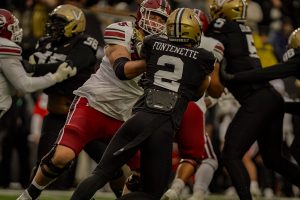
It doesn’t matter what’s causing these issues, though. At the end of the day, a missed tackle represents a missed opportunity, and Nov. 9 felt like the first time Vanderbilt’s opponent really made it pay for its tackling shortcomings.
South Carolina started with the ball in the second half, and the game was still within striking distance at just 7-0. A holding penalty pushed it back inside its 15-yard line before Khordae Sydnor seemingly broke through to Sellers as he wrapped him up inside the five-yard line. However, Sydnor didn’t get enough of Sellers as the quarterback broke out of the would-be sack and rolled right to find Jared Brown for a 51-yard gain.
Two plays later, CJ Taylor missed a hit on Sanders as he torched the Commodores’ defense and found paydirt on a 33-yard touchdown scamper. Vanderbilt went from pushing South Carolina back against the end zone and flipping the field to going down 14-0, all because of two plays where it missed tackles.
“They [have] a big running back, and we struggled to bring him down sometimes,” Taylor said. “With the quarterback, we struggled tackling.”
It would be naive to insist that Vanderbilt make every tackle — there isn’t a team in the country capable of wrapping up every time. See South Carolina’s defense, which was dominant all afternoon; it still missed seven tackles. The SEC boasts gifted athletes. Those athletes will always break tackles, but the Commodores need to better capitalize on the defensive opportunities given to them. Who knows how Saturday’s game would have played out had Sydnor sacked Sellers?
Lunch break
Vanderbilt’s bye week could not come at a better time. The Commodores just made it through the longest stretch of their season, playing six games in six weeks (five of which came against SEC teams, no less). Props to the ‘Dores for winning four of those six games, but now, it’s time for them to rest up.
It’s become abundantly clear that Vanderbilt’s banged up. South Carolina is an extremely physical team, and Beamer was always going to use his team’s size and athleticism to his advantage, but the Commodores just weren’t operating at 100% in this contest.
It starts with Pavia, who missed brief parts of Vanderbilt’s games against Kentucky and Texas with a leg injury. It was never a concern that Pavia would miss time — Lea insisted that it would take an amputation to keep Pavia off the field — but he’s clearly playing injured.
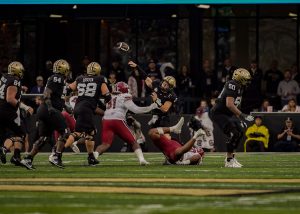
To make matters worse, Pavia took a shot with six minutes left in the fourth quarter against South Carolina and landed awkwardly. He got up momentarily and tried to jog off the field but ultimately had to sit back down while team trainers tended to him. The trainers helped him off the field and took him directly to the injury tent.
“I don’t have an update. I’ll have one this week,” Lea said about Pavia’s injury. “He’s being seen, and I’m not sure what’s going on, so I don’t want to comment.”
Pavia’s a warrior, and he’ll do everything he can to play, but his injury limits the explosivity of Tim Beck’s offense. Sedrick Alexander has been playing injured for the last few weeks, too. The sophomore back has failed to eclipse more than 3.4 yards per game in his last four games after averaging over 3.8 rushing yards in five of Vanderbilt’s first six games. Stowers has spent time on the injury report, as well, but seems to be mostly healthy for now.
Vanderbilt’s even more banged up defensively. Kolbey Taylor, Langston Patterson, Martel Hight, Linus Zunk and Miles Capers have all been flagged as questionable in the past few weeks. Patterson and Taylor went down with injuries in Week 11, too. Both players returned, but that’s just the nature of the game — they’ll play through a minor injury, assuming they can tolerate the pain without risking re-aggravation.
“I don’t feel too good right now, but it’s football,” Taylor said when asked about his injury.
Officially injured or not, it’s clear that Vanderbilt’s players are worn out and in need of a break. A performance like Saturday’s was bound to happen sooner or later, considering the brutal stretch of conference games the Commodores played.
For now, Lea’s group will lick its wounds and rest up as they prepare for a date with LSU in Death Valley on Nov. 23.


